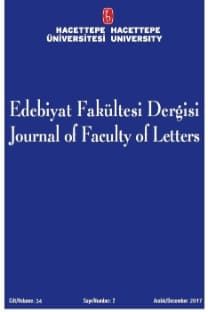A Gothic Ecocritical Analysis of Bram Stoker's Dracula
Bram Stoker'ın Drakula Adlı Eserinin Gotik Ekoeleştirel Bir İncelemesi
___
- Ağın Dönmez, B. (2014). Bang Your Head and Save the Planet: Gothic Ecocriticism. S. Oppermann (Ed.), in New International Voices in Ecocriticism. (pp. 71-83). Lanham: Lexington Books.
- Azarello, R. (2008). Unnatural Predators: Queer Theory Meets Environmental Studies in Bram Stoker's Dracula. N. Giffney and M. J. Hird (Eds.), in Queering the Non/Human (pp. 137-157). Hampshire: Ashgate.
- Barad, K. (2007). Meeting the Universe Halfway: Quantum Physics and the Entanglement of Matter and Meaning. Durham: Duke UP.
- Bennett, J. (2010). Vibrant Matter: A Political Ecology of Things. Durham: Duke UP.
- Botting, F. (1996). Gothic. London: Routledge.
- De Landa, M. (2002). Intensive Science and Virtual Philosophy. London: Bloomsbury.
- Estok, S. (2005). Bridging the Great Divide: Ecocritical Theory and the Great Unwashed. ESC: English Studies in Canada 31, 4: 197-209.
- ------. (2010). Reading Ecophobia: a Manifesto. Ecozon@ 1, 1: 75-79.
- Hanson, E. (1991). Undead. D. Fuss (Ed.), in Inside/Out: Lesbian Theories, Gay Theories. (pp. 324-340). New York: Routledge.
- Haraway, D. (1991). Simians, Cyborgs, and Women: The Reinvention of Nature. New York: Routledge.
- ------. (1995). Universal Donors in a Vampire Culture: It's All in the Family: Biological Kinship Categories in the
- Twentieth Century United States. W. Cronon (Ed.), in Uncommon Ground: Rethinking the Human Place in Nature. (pp. 321-378). New York: Norton.
- Hughes, W. (2013). Historical Dictionary of Gothic Literature. Lanham: The Scarecrow Press.
- Iovino, S., and Oppermann, S. (2014). Introduction: Stories Come to Matter. S. Iovino and S. Oppermann (Eds.), in Material Ecocriticism. (pp. 1-17). Bloomington: Indiana UP.
- Sullivan, H. I. The Ecology of Colors: Goethe's Materialist Optics and Ecological Posthumanism, in S. Iovino and S. Oppermann, (pp. 80-94).
- Stoker, B. (1897/1986). Dracula. London: Puffin.
- Wolfe, C. (1998). Critical Environments: Postmodern Theory and the Pragmatics of the "Outside." Minnesota: Minnesota UP.
- ISSN: 1301-5737
- Yayın Aralığı: 2
- Başlangıç: 1983
- Yayıncı: Emine Erdoğan Özünlü
The Green Shakespeare: An Ecocritical Reading
Silence to Sound: Narrating Hearing Loss and Beyond for Health Communication in Turkey
Geoffrey Chaucer's Hybrid Woman: The Prioress in The Canterbury Tales
Türk Standart Düzelti İşaretleri
Elçin YILMAZKAYA, F. Binnur ERDAĞI DOĞUER, Gülhan ÖZ AÇIK
Üniversite Düzeyinde Dil Öğrencilerinin Sözlük Kullanımı
Türk İşaret Dilinde Karşılığı Olmayan Sözcüklerin Çevirisinde Uygulanan Bazı Stratejiler
